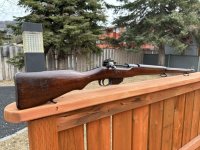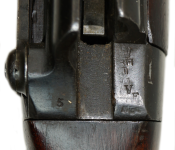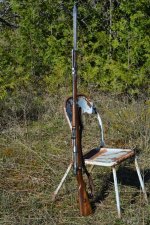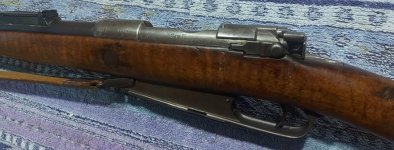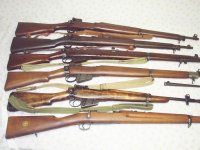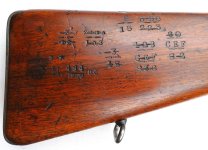Picture thread for WW1 era rifles that server in WW1 or plausibly could have - show and tell, let's see what people have in their vaults 
Only 2 rules to play: No "desporterized" guns and must have been in service in the 1914-1918 era - so no post-war made examples!!!
My current crop of (authentic and not de-sporterized facsimile) WW1 rifles is pictured here.

From left to right:
-Eddystone P14, non-Weedon Repair Standard, still in ww1 trim with volley sights present, RAF marked stock disk and RAF sling.
-A bit of a stretch here, but a 1909 DWM Argentinian cavalry carbine. Supposedly some of these might have been seized at the factory in 1914 (along with Chilean M1912's, Brazilian M1908's, etc.) and issued in small numbers to rear echelon German troops, but likely not this one. Still, it's great war era so I took some license and included it
-1915 RSAF Enfield SMLE MkIII (FTR in 1945 at Ishapore and converted to a MkIII*... but still, it did serve in the Great war)
-1910 BSA SMLE MkIII with volley sights and Australian 2MD issue markings.
-1918 Springfield M1903 MkI (later re-issued to the USMC in WW2)
-1891 Ludwig Loewe Gew 88/05 (matching except for Turkish replacement bolt)
-1896 Erfurt Gew 88/05 (Turk refurb)
-1916 Terni M91 Carcano
-OEWG Steyr M1888 Mannlicher (in the original 8x52R)
-1917 Steyr M95 (converted post-war to 8x56R)
I have the bayonets for all of these except for the 1909 carbine (just missed one at auction), the Mannlicher 1888, and the Springfield (had one and stupidly sold it at some point).
I'm sure some of you are hiding some real gems There are some guns I could have posted but didn't (like Martin-Henry and Snider Enfield rifles that maybe served in a home guard or something), but the above guns (except that 1909 carbine) were very likely in a trench, fortification, a tank or a dirigible at some point.
There are some guns I could have posted but didn't (like Martin-Henry and Snider Enfield rifles that maybe served in a home guard or something), but the above guns (except that 1909 carbine) were very likely in a trench, fortification, a tank or a dirigible at some point.
Only 2 rules to play: No "desporterized" guns and must have been in service in the 1914-1918 era - so no post-war made examples!!!
My current crop of (authentic and not de-sporterized facsimile) WW1 rifles is pictured here.

From left to right:
-Eddystone P14, non-Weedon Repair Standard, still in ww1 trim with volley sights present, RAF marked stock disk and RAF sling.
-A bit of a stretch here, but a 1909 DWM Argentinian cavalry carbine. Supposedly some of these might have been seized at the factory in 1914 (along with Chilean M1912's, Brazilian M1908's, etc.) and issued in small numbers to rear echelon German troops, but likely not this one. Still, it's great war era so I took some license and included it
-1915 RSAF Enfield SMLE MkIII (FTR in 1945 at Ishapore and converted to a MkIII*... but still, it did serve in the Great war)
-1910 BSA SMLE MkIII with volley sights and Australian 2MD issue markings.
-1918 Springfield M1903 MkI (later re-issued to the USMC in WW2)
-1891 Ludwig Loewe Gew 88/05 (matching except for Turkish replacement bolt)
-1896 Erfurt Gew 88/05 (Turk refurb)
-1916 Terni M91 Carcano
-OEWG Steyr M1888 Mannlicher (in the original 8x52R)
-1917 Steyr M95 (converted post-war to 8x56R)
I have the bayonets for all of these except for the 1909 carbine (just missed one at auction), the Mannlicher 1888, and the Springfield (had one and stupidly sold it at some point).
I'm sure some of you are hiding some real gems
Last edited:















































